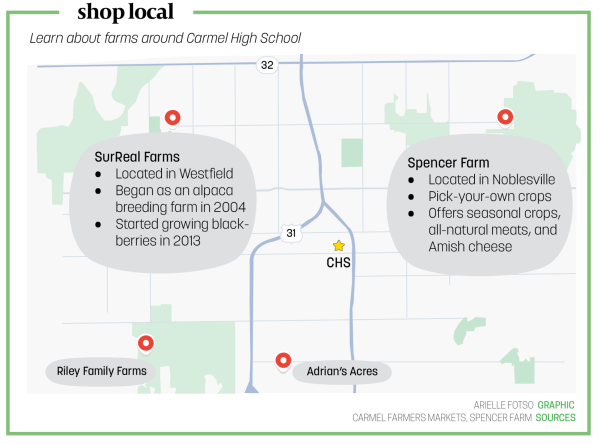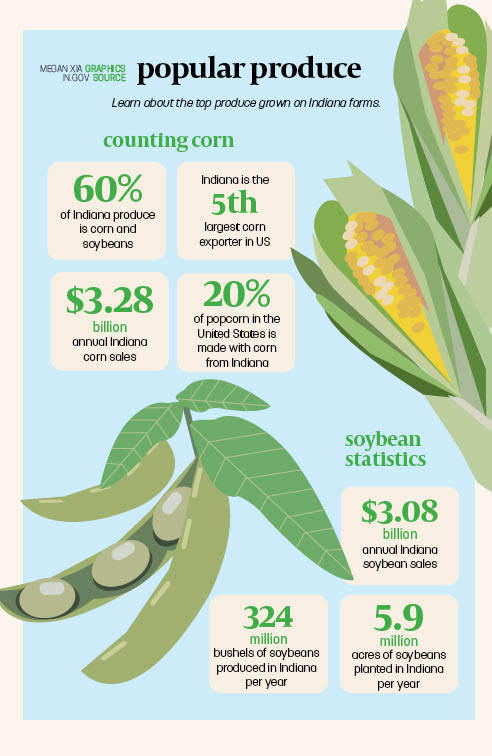Senior Riley Abernathy’s family has owned a farm for decades. Abernathy said that for as long as she can remember, maintaining her family farm has been an integral part of her day-to-day life.
“We start the season seeding and planting. We grow things indoors before planting them outside. Then, we have a whole series of weeding and harvesting, and then we prepare for the winter and get our cover crops down. Then it all starts again,” Abernathy said.
“It’s been a family owned farm for about forty years,” she continued. “Ever since my dad was a little kid, we’ve grown produce and had livestock and had lots of little side hustles.”
Not only is her family’s farm a big part of Abernathy’s life, but it has also been an integral part of her family’s recent history.
“(Our farm) was inherited, and a typical path for a lot of Hoosiers at the time was to have a homestead and make a profit from it,” Abernathy said.
Social studies teacher Allison Hargrove spent her formative years aiding her family-owned farm, and she said she relates to the hereditary component of Abernathy’s experience.

“My family owns a farm that has been in our family for several generations in Tipton County,” Hargrove said. “It’s still an operational farm. We actually farm our own ground and we own our own corporation as well. It is a seed business (in which) we sell and distribute and process (our products).”
Science teacher Cameron Huffman said farming is an important part of sustaining societies.
“When you talk about earth and (how) we’re able to sustain a population, agriculture really allowed us to organize ourselves within living units. We were no longer worried about where food was coming from- you could grow it right where you were living. You didn’t have to be nomadic in nature. Agriculture really just gives you a sense of food security,” Huffman said.
However, stories of family-owned farms, such as Abernathy and Hargrove’s, are continuously becoming more and more unusual. Although agriculture may have once been common among Americans, farmland has been decreasing exponentially as of late. According to a 2024 study conducted by the University of Illinois, over the past few decades, the USA has lost nearly 75 million acres of farmland, accounting for approximately 8% of all agricultural land in the country.
Huffman said he could confirm the aforementioned statistics, and said he has observed the same loss of farmland occuring in Indiana.
“One of the things we focus on in (AP Environmental Science) is the concept of urban sprawl, which is where cities and developments will kind of grow upward instead of outward,” Huffman said. “In Westfield, for example, and in west Carmel, there’s been a huge loss (of farmland). That was five or six miles of agricultural fields that had just been sold to new developers, and new homes were built there. Suddenly, you lose all this farmland, and this isn’t just happening in Carmel or Westfield. We’ve had a huge loss of agriculture.”
However, Abernathy said farming has been a comfortable and sustainable niche for her and her family.
“(Engaging in farm life) is kind of what we’ve always done. We’re in a very fortunate situation where my parents can have full-time jobs and farm on the side. We’ve got all the equipment and necessary time, and it’s definitely something we enjoy a lot and something we’re able to do,” Abernathy said.
Hargrove also said while farmland is undeniably decreasing worldwide, there are still pockets of robust farm life across the globe.
“Tipton County is very (agriculturally) based, even to this day. If you drive through it, you notice that there are fields everywhere. The farming community is ingrained into the culture,” Hargrove said.
Huffman said he agrees with Abernathy and Hargrove, and added that although Carmel is not doing a good job of preserving traditional farm land, the city is doing a commendable job of implementing nontraditional natural aspects into urban areas.
“I think (Carmel) is being creative with the green spaces they’re able to carve out,” Huffman said. “The parks system in Carmel is tremendous.”

However, Huffman said there are easy ways Carmel can perpetuate a more sustainable environment.
“If you’re establishing green spaces or agricultural areas within urban areas, you can provide a place for groundwater to be trapped, instead of it just running off. That would help with urban flooding. If you farm locally you can help improve water quality, and you can help improve resilience against heavy rain events,” Huffman said.
Abernathy said she agrees with points made by Huffman, and said living on her family’s farm has led her to want to pursue a career in sustainable agriculture.
“I’m looking into agriculture for college,” Abernathy said. “I had a summer internship at a farm, which gave me a lot of good experience for that (path), and I think (my experience) has really set me up for a good career in agriculture.”
Abernathy added, “I love sustainable agriculture. I’d ideally have an organic farm, but I’m also looking into agricultural engineering and agricultural economics. There are so many fields to go into.”
While also impacting her career choice, Abernathy said living on a farm has served to improve her work ethic.
“I credit most of my work ethic to (my) ability to just go outside, spend all day doing work, and get up and do it the next day, (all while) having a good attitude about it,” Abernathy said.
Hargrove agreed that living on a farm instills one with a good work ethic. She said working on a farm taught her the value of hard work.
“When I was a kid, you just worked. You woke up, contributed, had responsibilities around the house, even if they weren’t farm responsibilities, when you were doing things in the house it was so my dad could go and work on the farm. So everyone really pitched in,” Hargrove said.
Hargrove added, “Even now as an adult I think about the persistence I was raised with and how that work ethic is just ingrained into who I am.”
While Abernathy said working on her family farm has taught her valuable skills, she said it has also taught her to adapt to the two different environments of suburban Carmel and the rural area Abernathy farms is located in.
“I think it’s very unique to experience (both agricultural and suburban) environments,” Abernathy said. “People love that I bring them pumpkins and tomatoes and stuff like that, and I feel the love, but it is kind of a crazy (thing) to switch back at home.”
While Abernathy said her dual rural and suburban upbringing can cause her to have mini-culture shocks, she said she appreciates the sense of community having a family farm brings.
“Every year, we (host) a fall festival, where we invite all of our family and neighbors down (to our farm). Everyone carves pumpkins, and we have a bonfire,” Abernathy said.” It’s really fun, and it’s just a good way to celebrate the end of the harvest season.”

(Keira Kress)
Hargrove agreed that community within farming is important, and said her family farm allowed her family to become more close-knit and also learn the history of their ancestors.
“(The farm) felt like part of my family’s legacy, and part of my identity in many ways… legacy and family history are drilled into our brains from an early age, and there’s something to be said for a small community where your family has been in the community for a really long time,” Hargrove said. “Knowing that family history was really powerful.”
Despite the amount of family farms in Indiana decreasing over the past several years, Hargrove said Indiana continues to be rightly defined by the family farmers who helped build the state and its culture.
“I think there are certain things that are stereotypically associated with our state and farming is one of them, rightfully so, as it is the heritage of our state,” Hargrove said. “(Farming represents) who we are and I think that’s something to be proud of.”



